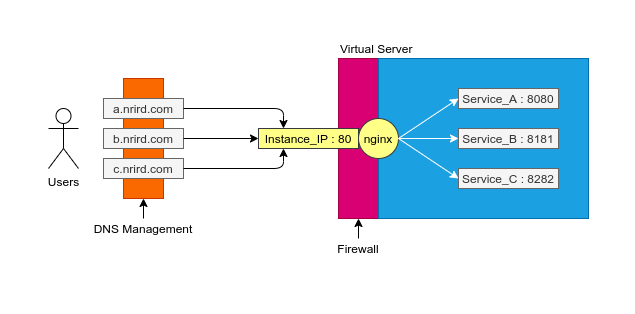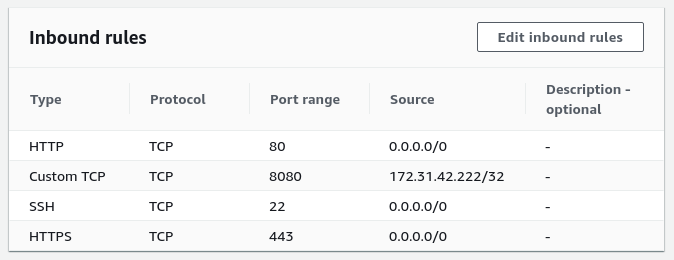Overview
Configuring a single virtual server to handle multiple subdomains involves several key components, including the choice of a virtual server, DNS management, the use of nginx as a proxy, and the deployment of a LAMP stack. In this illustration, I detail the setup process using an Amazon EC2 instance, Cloudflare Managed DNS, nginx, and Docker containers (represented as “Service_*”).

Virtual Server
For this configuration, an Amazon EC2 instance from AWS serves as the virtual server. EC2 provides scalability to meet changing cloud computing needs. The firewall solution, known as a Security Group, manages incoming and outgoing traffic to the EC2 instance.

For those seeking a more cost-effective and streamlined server instance, AWS offers a service called Lightsail.
DNS Management
Cloudflare Managed DNS is utilized to manage the primary domain’s DNS. This enterprise-grade service not only offers fast response times but also includes advanced security features such as DDoS mitigation and DNSSEC. The DNS records for subdomains are configured to proxy through Cloudflare for the benefits of free Universal SSL certificates with automatic renewal.
Example DNS records:
| Type | Name | Content | Proxy status |
| A | a.nrird.com | EC2_Instance_IP | Yes |
| A | b.nrird.com | EC2_Instance_IP | Yes |
| A | c.nrird.com | EC2_Instance_IP | Yes |
Nginx
nginx serves as both an entry point to the EC2 instance and a load balancer, directing traffic to the respective services running in Docker containers. The nginx configuration includes server blocks for each subdomain.

nginx.conf
The nginx configuration in the nginx.conf file includes settings such as worker processes, error logging, and server blocks for each subdomain. Each block specifies the proxy settings for routing traffic to the corresponding Docker container.
user nginx;
worker_processes auto;
error_log /var/log/nginx/error.log;
pid /run/nginx.pid;
include /usr/share/nginx/modules/*.conf;
events {
worker_connections 1024;
}
http {
server_names_hash_bucket_size 128;
log_format main '$remote_addr - $remote_user [$time_local] "$request" '
'$status $body_bytes_sent "$http_referer" '
'"$http_user_agent" "$http_x_forwarded_for"';
access_log /var/log/nginx/access.log main;
sendfile on;
tcp_nopush on;
tcp_nodelay on;
keepalive_timeout 65;
types_hash_max_size 4096;
include /etc/nginx/mime.types;
default_type application/octet-stream;
include /etc/nginx/conf.d/*.conf;
server {
listen 80;
server_name a.nrird.com;
index index.html index.htm index.php;
location / {
proxy_set_header X-Real-IP $remote_addr;
proxy_set_header Host $http_host;
proxy_set_header X-Forwarded-For $proxy_add_x_forwarded_for;
proxy_set_header X-NginX-Proxy true;
proxy_pass http://127.0.0.1:8080;
proxy_redirect off;
break;
}
}
server {
listen 80;
server_name b.nrird.com;
index index.html index.htm index.php;
location / {
proxy_set_header X-Real-IP $remote_addr;
proxy_set_header Host $http_host;
proxy_set_header X-Forwarded-For $proxy_add_x_forwarded_for;
proxy_set_header X-NginX-Proxy true;
proxy_pass http://127.0.0.1:8181;
proxy_redirect off;
break;
}
}
server {
listen 80;
server_name c.nrird.com;
index index.html index.htm index.php;
location / {
proxy_set_header X-Real-IP $remote_addr;
proxy_set_header Host $http_host;
proxy_set_header X-Forwarded-For $proxy_add_x_forwarded_for;
proxy_set_header X-NginX-Proxy true;
proxy_pass http://127.0.0.1:8282;
proxy_redirect off;
break;
}
}
}
LAMP stack
A LAMP stack, comprising Linux, Apache, MySQL, and PHP, is deployed within Docker containers on the EC2 instance. nginx is used to proxy traffic to these containers. The advantages of running the LAMP stack in containers include maintaining system cleanliness, enhanced security, easier app version updates, simplified configuration management through a single docker-compose.yml file, and improved control over port accessibility.
For those interested, my LAMP deployment configurations are available on GitHub.